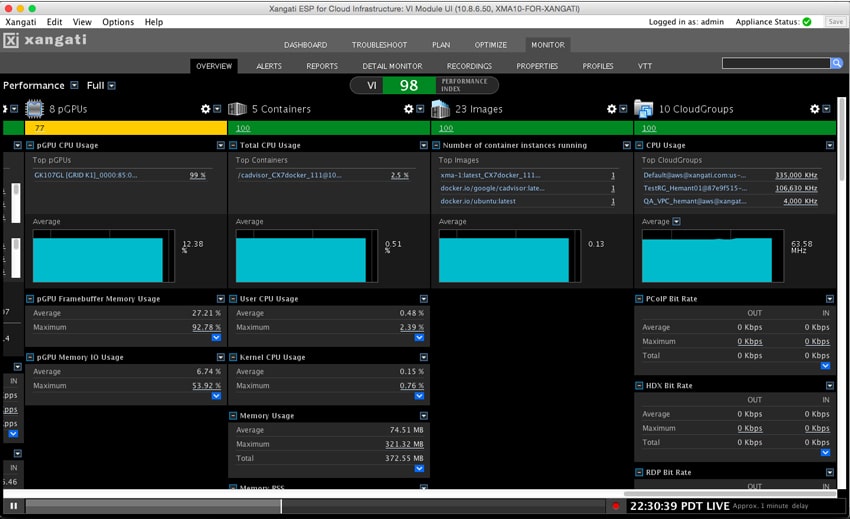Today Xangati announced its next-generation service assurance analytics and performance control platform, Xangati ESP for Cloud Workspace and Cloud Infrastructure. Xangati is also announcing four new data-source compute extensions. Now customers using NVIDIA physical GPUs, Amazon Web Services (AWS), Microsoft Azure and Docker will be able to use Xangati’s virtual appliance software to correlate real-time data across on-premise virtualization, containers and public clouds to enable self-healing optimization.
Today Xangati announced its next-generation service assurance analytics and performance control platform, Xangati ESP for Cloud Workspace and Cloud Infrastructure. Xangati is also announcing four new data-source compute extensions. Now customers using NVIDIA physical GPUs, Amazon Web Services (AWS), Microsoft Azure and Docker will be able to use Xangati’s virtual appliance software to correlate real-time data across on-premise virtualization, containers and public clouds to enable self-healing optimization.
Headquartered in San Jose, California Xangati solutions provide intelligent performance management of workloads running in VI and VDI environments. Xangati has over 400 customers that include eBay, Comcast, Guess, Univita Health, Harvard University, and the US Army. For these customers, Xangati provides visibility across their entire infrastructures avoiding silos of inaccessible and out of date information to deliver consumptive and interactional information.
Hybrid-cloud infrastructure can run into unpredictable performance problems and resource inefficiency challenges due to their ability to accommodate multiple applications, a shared or converged physical layer, and a software-defined layer. Administrators have a few ways to monitor their hybrid-cloud infrastructure for issues: conventional monitor solutions and application performance management (APM) solutions, both of which Xangati feels are inadequate. Xangati’s solution, Xangati ESP for Cloud Infrastructure, maps infrastructure behavior to autonomic controls across traditional silos in real time and analyzes impacts to virtual application performance, efficiency and delivery to optimize the end-user quality of experience across any compute platform from private to hybrid cloud. Xangati’s ESP offers self-healing support for new compute environments, new storage and networking data sources, and enhanced visibility into VDI end-user metrics, spanning a range of software dashboard modules for Virtual Infrastructure, Virtual Desktop Infrastructure (VDI) and Virtual Applications.
Additional features of the Xangati ESP platform include:
- Xangati ESP Extension for EMC VNX: Deep integration into EMC VNX storage pools that reports the IOPS, throughput and latency metrics that EMC VNX is contributing to the hypervisors (file, block, unified). Additionally, data on NFS or CIFS shares, iSCSI or Fibre Channel LUNs and CPU utilization and overall network bit-rates are collected.
- Xangati ESP Storage Module: Designed for the storage infrastructure and virtual storage objects. Xangati collects metrics on the IOPS, throughput and latency of each datastore as well as the number of hypervisors and guest VMs using each. Xangati monitors the choke-points for storage systems, typically the network interfaces through which storage talks to the controllers that perform read/write transactions, the disks’ ability to deliver I/O, and/or the flash memory’s ability to cache and deliver I/O.
- Control enhancements of automated contention-storm analysis including for efficiency (alert driven remediation to avoid degrading conditions, and v-storm driven remediation) and for prescriptive remediation actions (migration, modify memory or CPU, scale up or down, power off or on).
- Live visibility into and on-demand reporting of XenApp, XenDesktop and Horizon View availability and performance VDI metrics
- Device-independent, app-driven Visual Trouble Ticket capability
Now Xangati offers extension for NVIDIA GPUs, AWS, Azure, and Docker that are subscription licenses stackable on top of a required subscription license for the core Xangati ESP for Cloud Infrastructure platform. For AWS and Azure, the extensions can analyze CPU, Memory and Storage utilization of an organization’s virtual machines and associated objects, and Virtual Private Cloud VMs hosted in an AWS or Azure account. According to Xangati, these extensions will enable system administrators to optimize the performance and utilization of their hybrid-cloud infrastructure assets with agentless second-by-second accuracy.
The Xangati ESP Extension for Docker tracks and correlates metrics for containers and images so that they can be profiled and alerted upon within the overall context of end-to-end visibility and performance control services provided by Xangati. The extension for NVIDIA GPUs can tell administrators the performance XenServer’s hypervisor pGPU utilization and enables them to optimize utilization for optimal performance on end-user VDI graphic accelerations.
Xangati is also adding a new index for pattern anomalies that correlates and analyzes end-user behavior across the spectrum of ESP modules and extensions. This new anomaly index will be able to do the following:
- Measure unusual or suspicious activity associated with VMs, Services and Hosts
- Screen for anomalous interactions such as “affinity counts,” or the number of objects the anomaly index is interacting with; such anomalous interactions typically indicate potential security breaches (Virus/Worms, DDoS, SpamBot, Data Leakage)
- The anomaly index is another useful source of threat intelligence for hybrid-cloud environments where data protection, data privacy and high availability are always high priorities.
Sign up for the StorageReview newsletter

